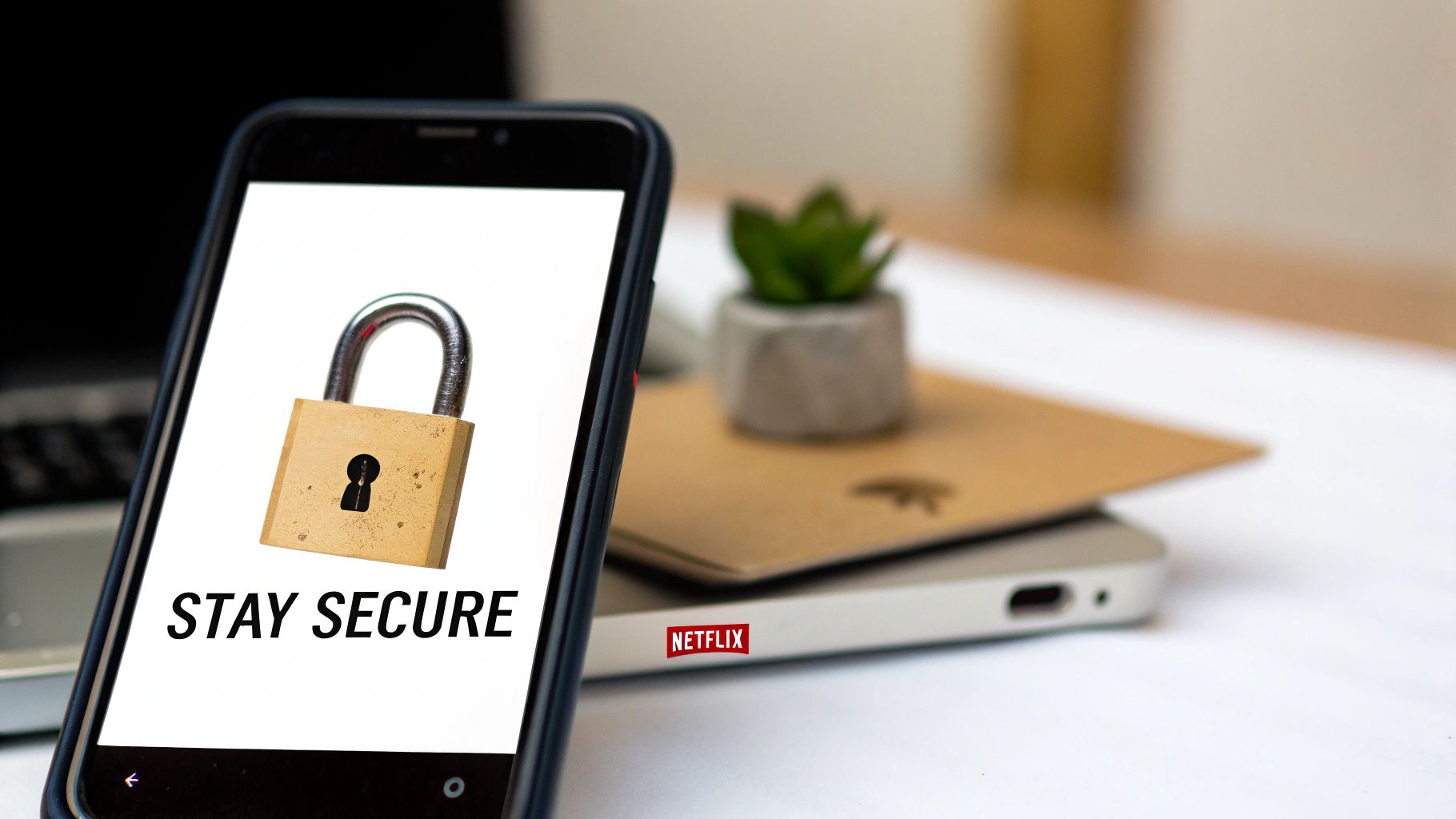
Share Netflix Account the Right Way: Your Complete Guide
Share
Navigating the New World of Netflix Account Sharing

Sharing a Netflix account used to be simple. Now, the landscape has changed considerably. Initially, password sharing fueled Netflix’s impressive growth. But as the streaming market became more competitive, Netflix has had to adapt.
This shift reflects the company's challenge: balancing accessibility with revenue growth. Understanding the new rules is essential for all Netflix subscribers.
The sheer scale of account sharing has a significant impact on Netflix's subscriber numbers. As of early 2023, over 100 million households were accessing Netflix via shared accounts. This included over 30 million in the U.S. and Canada alone.
Netflix largely overlooked this during its early expansion. However, as growth slowed, the company recognized the need to monetize shared accounts. This move underlines Netflix's drive to find new revenue streams and stay competitive. For more detailed statistics, check out An Update on Sharing.
Understanding Netflix's "Household" Definition
Central to the new Netflix account sharing rules is the concept of a "household." This isn’t as straightforward as it might appear. Netflix defines a household as those living at the same physical address as the primary account holder.
This policy aims to confine sharing to immediate family and those living together. It’s a more restrictive approach than the previous, more lenient practice.
Geographic Boundaries and Account Access
Geographic boundaries also play a significant role in Netflix's account management. You can access your account while traveling, which is convenient for subscribers on the go.
However, extended usage from a location different from your primary residence might raise red flags. This can trigger warnings or even account restrictions. Netflix monitors login patterns and device locations to prevent sharing outside the defined household.
To understand how these changes have affected users over time, take a look at the table below. It summarizes the evolution of Netflix's account sharing policies.
A comparison of how Netflix's approach to account sharing has evolved over time:
| Time Period | Official Policy | Enforcement Level | User Impact |
|---|---|---|---|
| Early Years (Pre-2023) | Loosely defined; sharing widely tolerated | Minimal enforcement; few restrictions | Widespread sharing; minimal impact on users |
| 2023-Present | Stricter "household" definition; focus on primary location | Active monitoring of IP addresses and devices; restrictions for out-of-household sharing | Increased restrictions on sharing; potential for account limitations and extra fees for additional members |
The table highlights the key differences between Netflix's past and present policies regarding account sharing. The shift towards stricter enforcement and the introduction of the “household” definition are the major changes.
How Netflix Identifies Unauthorized Sharing
Netflix uses several methods to detect unauthorized account sharing. The platform tracks IP addresses and device IDs to monitor account access. This allows them to see where and how an account is being used.
Frequent logins from various locations or many devices linked to a single account can trigger alerts. This monitoring helps Netflix enforce its sharing policies and encourages users to stick to the terms of service. Understanding these factors is vital for responsible account sharing.
The Official Ways to Share Your Netflix Subscription

Netflix encourages account sharing, but within established guidelines. This involves understanding the official options, primarily centered around the extra member feature. This system allows account holders to extend their subscription to individuals outside their household for an added cost. Let's explore the details.
Understanding the Extra Member Feature
The extra member option offers a legitimate avenue for sharing your Netflix account with people outside your home. However, this feature isn't universally available. Its availability and pricing depend on your region and your specific Netflix plan. This can be tricky for users trying to figure out the best option.
Adding an extra member typically involves a straightforward process within your Netflix account settings. You'll send an invitation to the person you'd like to add. They'll then create a personal profile, connected to your main account, but with their own individualized recommendations and viewing history.
Managing Profiles and Streaming Limits
A common question about sharing a Netflix account involves simultaneous streaming. The number of concurrent streams permitted remains tied to your Netflix plan, regardless of the number of extra members. For instance, a Standard plan might allow only two simultaneous streams, even with extra members. This means someone will be blocked if three people try to watch at the same time.
Managing profiles is key to preventing conflicts. Each person sharing the account should have a separate profile, allowing Netflix to tailor recommendations and track individual viewing progress. This also prevents viewing history from becoming jumbled and maintains separate preferences. You might find this helpful: How to master sitemaps.
Profile Transfer: A Path to Independence
Profile transfer is another significant feature for account sharing. This allows users previously on a shared account to move their personalized profile, complete with viewing history and recommendations, to a brand-new, independent Netflix account.
This is especially useful if someone moves out or wants a personal subscription. It provides a smooth transition without sacrificing years of personalized viewing data. The ability to transfer profiles offers flexibility for users changing living arrangements or seeking more control over their Netflix experience.
Netflix's Evolving Strategy
In recent years, Netflix has focused on managing account sharing with new policies and features. For example, in 2023, Netflix piloted a model in Latin American countries, including Costa Rica, Peru, and Chile, allowing subscribers to add sub-accounts for people outside their household at a reduced cost.
This initiative reflects Netflix's broader strategy to shift from tolerating password sharing to monetizing it more effectively. Surveys reveal mixed reactions to these changes, with some users willing to pay for official sharing options, while others resist increasing subscription costs. You can explore more detailed statistics here. Clearly, Netflix is constantly refining its approach to account sharing, striving to balance user needs with business objectives.
The Real Cost Analysis: Is Sharing Actually Worth It?

Beyond the advertised price of a Netflix subscription, what are the true costs associated with sharing your account? This question is essential for anyone thinking about splitting their Netflix bill. Let's explore the financial realities.
Breaking Down The Cost Structure
At first glance, sharing a Netflix account appears to offer significant savings. However, it’s crucial to conduct a thorough cost analysis. This involves understanding the various subscription tiers and the expenses associated with adding extra members. A comprehensive cost analysis will illuminate both the advantages and disadvantages.
For example, splitting a Premium plan among four people may seem inexpensive per person. But how does that cost compare to four individual Basic plans, especially if not everyone requires the higher resolution offered by the Premium tier? The difference might be surprising. Also, consider the streaming limitations of each plan, like the number of simultaneous streams.
Hidden Expenses and Value Propositions
There are often hidden expenses associated with sharing a Netflix account. For instance, some users employ VPNs to access content from different regions. These services often come with their own recurring fees. This added cost can offset some of the perceived savings. Learn more about various online tools and resources in our article about how to master sitemaps and more.
Alternatively, family plans provide distinct benefits. They typically permit multiple profiles and simultaneous streams, catering well to larger households. Though pricier than a Basic plan, a family plan may be a better value than adding multiple extra members to a cheaper subscription.
Real-World Scenarios: From Roommates To Families
Let's consider college roommates. Pooling resources for a single Netflix account seems like a smart move. However, factoring in potential VPN costs for students accessing the account from different locations during breaks, a different strategy could prove more economical.
Another common scenario: a family spread across the country. While sharing a single account might seem convenient, restrictions on simultaneous streaming and differing viewing preferences might make individual accounts, even at a higher overall cost, a more practical solution.
Optimizing Your Strategy: Viewing Habits and User Needs
The best Netflix sharing strategy depends on factors like individual viewing habits, the number of users, and desired streaming quality. A detailed cost comparison is critical for informed decision-making.
To help visualize the costs, let’s examine a breakdown of different Netflix access options.
The following table provides a detailed breakdown of costs associated with different Netflix subscription and sharing methods:
| Access Method | Monthly Cost | Annual Cost | Features | Limitations |
|---|---|---|---|---|
| Basic (Individual) | $9.99 | $119.88 | Standard Definition (SD), 1 Screen | Limited Resolution, Single Stream |
| Standard (Individual) | $15.49 | $185.88 | High Definition (HD), 2 Screens | No Ultra HD, Two Simultaneous Streams |
| Premium (Individual) | $19.99 | $239.88 | Ultra High Definition (UHD), 4 Screens | Highest Cost |
| Standard (Shared - 2 People) | $7.75 (per person) | $93 (per person) | HD, 2 Screens (total) | Potential Scheduling Conflicts |
| Premium (Shared - 4 People) | $5.00 (per person) | $60 (per person) | UHD, 4 Screens (total) | Coordination Required Among Users |
As the table illustrates, the cost per person decreases significantly when sharing a Premium plan. However, the limitations of shared accounts, such as the number of simultaneous streams and potential scheduling conflicts, should be considered.
Choosing the right approach involves balancing cost savings with the convenience and flexibility of individual accounts. Think carefully about your specific needs to maximize your entertainment value while minimizing costs.
How Viewers Are Responding to Sharing Restrictions

Netflix's crackdown on password sharing has generated a wide spectrum of reactions. Some subscribers have adapted smoothly, while others are pushing back against the changes. Let’s delve into the diverse responses to these new restrictions.
Adapting to the New Rules
Many users have embraced the official Netflix sharing options. Some opted to add extra members to their accounts, absorbing the added cost. This provides a convenient solution for those sharing with a small number of people outside their homes.
Others have upgraded to family plans. They recognize the value of multiple profiles and the ability to stream simultaneously. This often makes sense for larger households or groups wanting uninterrupted access.
Additionally, some have simply created entirely separate Netflix accounts. This allows for greater personalization and avoids potential viewing conflicts, though it does increase the overall cost. This individualized approach prioritizes control and convenience.
Resistance and Workarounds
Not everyone is happy to pay more. A significant number of users continue to share Netflix accounts as before, seemingly unaffected by the restrictions. As of mid-2024, a survey indicated that many Netflix subscribers sharing passwords with one to two other people had not changed their sharing practices.
This suggests that a segment of users remain resistant to paying extra. Despite these challenges, Netflix's subscriber base has grown, partially due to its password-sharing policies and the introduction of ad-supported tiers.
In the first quarter of 2024, Netflix added 9.33 million new subscribers. This reflects a positive trend amid efforts to manage account sharing. Discover further insights here.
The Spectrum of Responses: Cancellations and Creative Solutions
Reactions to Netflix's sharing restrictions range from account cancellations to creative workarounds. Some users, frustrated by the changes, have canceled their subscriptions. They may be exploring other streaming platforms or different entertainment options.
Others are finding more innovative solutions. For example, strategic subscription rotation, where friends take turns paying for a single account monthly, is gaining traction. This collaborative approach distributes the cost and maintains continued access.
Ultimately, viewers are responding to Netflix's sharing restrictions in a variety of ways, demonstrating adaptability, resistance, and the pursuit of alternative solutions. The long-term impact of these policies on Netflix and the wider streaming landscape remains to be seen.
Behind the Scenes: How Netflix Tracks Shared Accounts
Netflix's crackdown on account sharing has many users wondering how the platform detects unauthorized access. Netflix uses a combination of methods to monitor and identify sharing outside of a single household. Let's delve into these techniques.
IP Addresses and Device IDs: The Foundation of Tracking
Netflix primarily relies on IP addresses and device IDs. Your IP address acts as your digital location, indicating your general geographic area. Every time you log in, Netflix records this information. Similarly, each device, whether a smart TV, smartphone, or laptop, has a unique device ID. Netflix uses these identifiers to build a profile of your viewing habits and the devices connected to your account. This helps them spot unusual activity, such as numerous logins from different locations or an excessive number of devices on one account.
Login Patterns: Identifying Suspicious Activity
Beyond simply tracking locations and devices, Netflix also monitors login patterns. Consistent logins from geographically distant locations can trigger a red flag. For instance, regular logins from New York and California within short timeframes might raise suspicion. This doesn't mean you can't travel and use your account. Occasional logins from various locations are expected. However, frequent access from vastly different places suggests sharing outside the household, potentially leading to warnings or further investigation.
Simultaneous Streaming Limits: How They Work
The number of simultaneous streams allowed on your account reinforces the "household" concept. If an account allows two simultaneous streams and three people attempt to watch from different locations, one will be blocked. This limit, tied to your subscription tier, presents a practical challenge for sharing. Even for legitimate extra members, these limits can cause inconvenience, requiring careful management of viewing schedules.
Device Management and Content Availability Challenges
Managing devices across profiles introduces technical complexities to sharing. While Netflix allows multiple profiles, downloaded content is linked to specific devices. This means downloaded shows on one profile might not be accessible on another person's device, even within the same account. Further complicating matters, content availability varies by region due to licensing agreements. Content accessible in one location might be unavailable elsewhere, even on the same account.
Practical Strategies for Account Management
For those sharing within Netflix’s guidelines, effective profile management is crucial. Each user should have a separate profile for personalized recommendations and viewing histories. For more organizational tips, you can learn about managing sitemaps. Understanding how Netflix tracks accounts empowers users to avoid unexpected disruptions. By adhering to Netflix’s terms and efficiently managing your account, you can optimize your streaming experience while staying within the rules. This ensures uninterrupted access to your favorite movies and shows.
Beyond Netflix: Smart Alternatives to Account Sharing
When sharing your Netflix account starts feeling like a logistical nightmare or a drain on your wallet, it's time to explore other options. This means looking at different streaming services, changing how you subscribe, and even checking out free options. It's all about finding what works best for your entertainment needs and your budget.
Exploring Alternative Streaming Services
There are tons of other streaming platforms out there, each with its own content library, pricing, and sharing policies. Some are more relaxed about password sharing, while others offer great family plans at competitive prices. Doing a little research can reveal some gems that might be a better fit for your viewing habits. Plus, some services specialize in specific genres, providing a more focused experience than Netflix's broad catalog.
Strategic Subscription Rotation
Another smart strategy is subscription rotation with a group of friends. Each month, a different person pays for a service like Hulu, Disney+, or even Netflix. This spreads the cost around while still giving everyone access to a variety of content throughout the year. It does require coordination and trust, but it's a super cost-effective way to access multiple platforms.
Bundling and Free Ad-Supported Options
Bundling services with your internet or phone provider can also unlock significant discounts. Many telecommunication companies offer packages that include streaming subscriptions, potentially lowering your overall entertainment bill. And don't forget about free ad-supported streaming services like Tubi, Crackle, and Pluto TV. They offer a surprisingly large amount of content. While they may not have the newest releases, they can be a valuable addition to your paid subscriptions, reducing your reliance on a shared premium account.
The Benefits of Separate Subscriptions
Having your own subscription, while seemingly more expensive upfront, can actually offer some unexpected advantages. Personalized recommendations become much more accurate when each user has a dedicated profile. This avoids the algorithm confusion that happens when multiple people share the same account. It also prevents one person's viewing habits from dominating everyone else's recommendations.
Perhaps the biggest perk is unrestricted access. With separate accounts, say goodbye to viewing conflicts. Everyone can watch whatever they want, whenever they want, without worrying about simultaneous streaming limits. This added freedom and flexibility can greatly enhance your viewing experience, particularly in larger households.
Cost Comparisons and Content Analysis
Figuring out the best option for you requires careful consideration. Compare the annual costs of individual subscriptions versus shared or rotating subscriptions. Don’t just look at the monthly fee; factor in any potential hidden costs. Equally important is a content analysis. Each platform has different shows and movies. Make sure the services you choose align with your viewing preferences. Think about your priorities: is a wide range of content more important, or is cost the main factor? Answering this question will help you decide whether sharing or individual subscriptions offer the best value.
By thinking beyond a shared Netflix account and exploring these alternatives, you can create an entertainment strategy that perfectly fits your needs and your budget.
Looking for a smarter way to manage and share your subscriptions? AccountShare provides a platform for group purchasing and secure account management, enabling you to access premium services at a fraction of the cost. Discover how AccountShare can improve your digital subscriptions!
